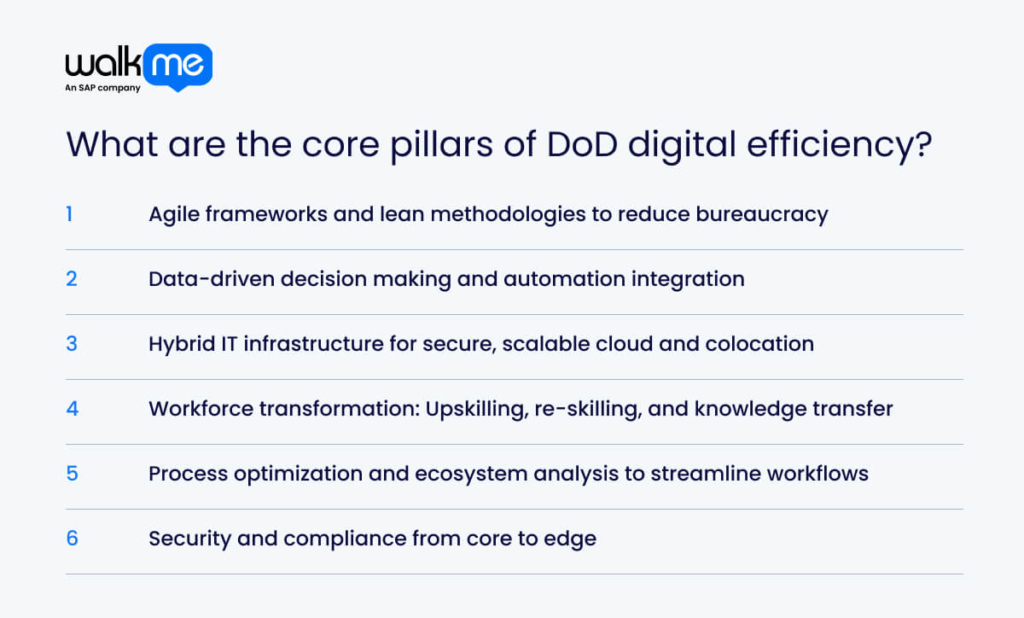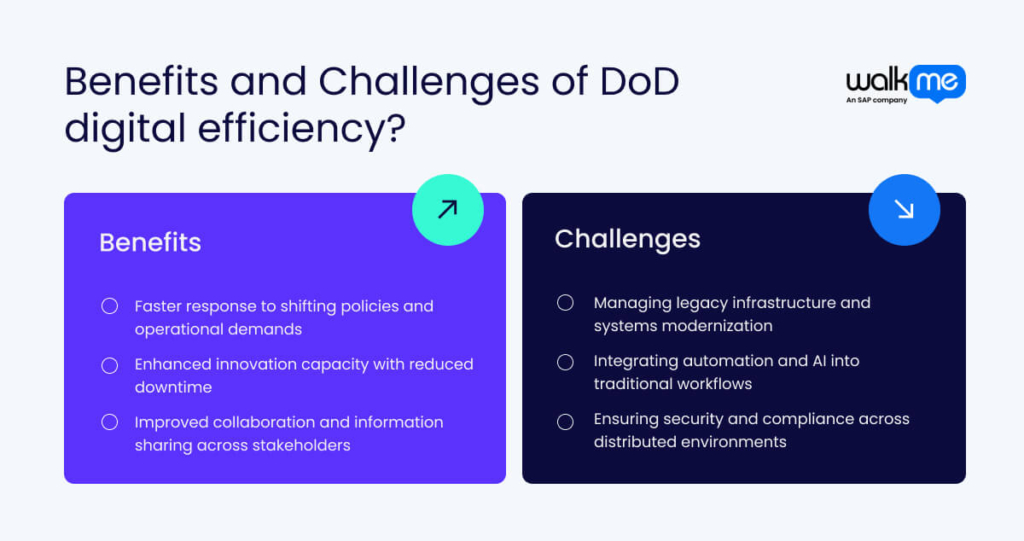The Fulcrum Strategy signals a shift toward modern networks and better coordination across military operations.
A key step is to use zero-trust security to protect systems while enhancing how data is shared and utilized. The new Chief Digital and Artificial Intelligence Office also supports faster decisions by using AI and analytics tools.
However, digital efficiency also means updating IT systems and helping staff develop the skills necessary for today’s complex security environment.
This article explores how the DoD advances digital efficiency through technology, process improvements, and partnerships to enhance agility and mission readiness.
What is digital efficiency at the DoD?
Digital efficiency at the DoD means enhancing the flow of information and the decision-making process across multiple systems.
It focuses on process automation, reducing errors, and keeping data secure, while getting the most value from technology and information.
This involves using tools like artificial intelligence (AI) and automation technology, while ensuring human judgment stays central.
It also requires digital reskilling and a culture that can adapt quickly to change.
For the DoD, achieving digital efficiency is crucial to remaining effective and ready in a world where technology moves at breakneck speed.
Why is digital efficiency at the DoD important?
The Department of Defense (DoD) needs digital efficiency to handle complex missions.
Sharing accurate information helps troops make smarter moves, whether on the ground or in the office. For example, during a recent training exercise, digital tools gave commanders real-time updates on enemy positions.
If digital tools lag behind, the military could overlook important particulars or respond too late. Keeping digital systems up to date means the DoD stays ready and effective in unpredictable situations.
What is the DoD software modernization plan?
The DoD’s software modernization plan laid the foundation for transforming how the DoD delivers software, with a focus on speed and reliability. The updated plan for fiscal year 2025/2026 builds on the progress made in previous years and adds new priorities.
This plan helps the DoD keep its edge in a world where software drives operations. It focuses on improving processes, supporting teams, and encouraging innovation. Let’s take a closer look at the main parts of the DoD’s software modernization plan:
Accelerate the DoD enterprise cloud environment
The DoD is growing its cloud ecosystems to handle more data and support different missions. The goal is to make cloud services fast, safe, and easy to use. Enhancing the cloud enables teams to access information and tools when needed, regardless of their location worldwide.
Establish a department-wide software factory ecosystem
The DoD wants to unify how software is built across all teams. Creating a shared environment facilitates collaboration among different groups. This setup encourages new ideas and consistent quality. Standard processes reduce delays and make it easier to share tools and best practices.
Transform processes to enable resilience and speed
The Department of Defense updates practices and methods to ensure agile software development. Changing policies allows teams to move quickly and respond to new challenges. Modern processes also help prevent delays and keep systems running smoothly, even when conditions change suddenly.
What are the core pillars of DoD digital efficiency?

Let’s take a closer look at the core pillars of digital efficiency in the DoD:
Agile frameworks and lean methodologies to reduce bureaucracy
Agile frameworks break large projects into smaller tasks, making progress easier to track and manage. Process improvement methodologies such as lean cut waste by removing steps that don’t add value. Together, they help reduce delays and improve focus. Teams deliver faster and adjust as needed, meaning they avoid long approval chains and focus on outcomes. It also allows leaders to spot problems early.
Data-driven decision making and automation integration
The Department of Defense collects a significant amount of information. Digital efficiency gives teams a clear path, helping them make quicker and more confident decisions. Automation supports this by handling repeat tasks and can update systems, flag errors, and share alerts. Humans still lead, but they get better tools with less guesswork and more control. It also saves time, resulting in faster responses and fewer delays on mission tasks.
Hybrid IT infrastructure for secure, scalable cloud and colocation
Hybrid IT refers to the use of both on-site systems and cloud-based tools. Some data remains local for security, while other workloads shift to the cloud for speed and scalability. This balance delivers flexibility, improves uptime, and reduces risk. When one system slows, another can take over, meaning teams stay connected, even across locations. It’s seen as safer, stronger, and better suited to different mission needs.
Workforce transformation: Upskilling, re-skilling, and knowledge transfer
The Department of Defense (DoD) faces rapidly changing threats, with evolving missions, priorities, and roles. Upskilling helps service members and civilians grow their current skills. Reskilling prepares them for new tasks, like working with AI. Workforce transformation means building a force that can adapt quickly. Field training, digital platforms, and peer learning all play a role. Knowledge management between units also helps prevent mission-critical knowledge from being lost or overlooked.
Process optimization and ecosystem analysis to streamline workflows
Modern IT systems are all interconnected. If one part slows down, the entire chain comes to a halt. Process improvement and optimization mean finding these gaps. It also means removing steps that cause delay. Data ecosystem analysis looks at how tools, people, and data move together. Leaders break down each part of the process, identify what slows it down, and seek ways to improve it.
Security and compliance from core to edge
Security must cover all points, even at the edge. This includes devices in the field and those currently in operation. The DoD uses layered defenses to detect threats early, meaning compliance conventions are followed at every step. When both are robust, data remains secure, and security supports swift action.
Balancing mission continuity with digital efficiency mandates at the DoD
Balancing operational readiness with efficiency goals remains a careful task for the Department of Defense. As digital mandates mature, the challenge lies in meeting them without disrupting core mission activities.
Let’s take a closer look at how mission continuity and digital efficiency mandates are balanced at the DoD:
Acting as a bridge between government and industry
The DoD works closely with private-sector partners to improve how technology and expertise move between sectors. These partnerships help align defense needs with real-world innovation. Clear contracts, shared goals, and open communication support this process. The industry offers speed and tools, and the DoD brings scale and a mission focus. This connection helps both sides learn from each other while staying aligned with national defense responsibilities.
Facilitating technology and knowledge transfer to sustain R&D
Programs that support research and development often rely on shared knowledge across agencies, labs, and contractors. The DoD promotes this transfer through structured frameworks and secure environments. Teams can reuse tools, models, and results, rather than having to start from scratch. This avoids duplication and supports faster progress. Ongoing collaboration makes it easier to maintain momentum, especially in emerging fields like AI, cyber operations, and advanced systems engineering.
Supporting workforce transitions with programs like SkillBridge
SkillBridge provides service members with a pathway to explore civilian careers before separating from active duty. It connects them with training, internships, and work placements in both public and private sectors. These programs also ease transitions while retaining valuable experience. For the DoD, it’s one way to keep institutional knowledge within reach, even as roles shift across missions, units, or career paths.
Documenting and sharing best practices to retain institutional knowledge
The DoD encourages teams to record lessons learned, so knowledge doesn’t disappear when people move on. Playbooks, internal wikis, and briefings help new staff pick up where others left off. Shared frameworks also make it easier to apply past insights to new problems. Consistent documentation supports learning at all levels, from field units to technical teams and senior leadership.

What are the benefits of DoD digital efficiency?
Digital efficiency is redefining the Department of Defense’s approach to complex technology challenges. It drives precision, speed, and collaboration at a scale never seen before.
Let’s take a closer look at the benefits of digital efficiency at the DoD:
Faster response to shifting policies and operational demands
Digital efficiency enables the DoD to update systems and processes in response to changing policies. For example, cloud-based platforms allow rapid deployment of new software patches. This reduces delays in adapting to evolving threats or directives, helping missions continue smoothly without costly downtime.
Enhanced innovation capacity with reduced downtime
Modernized software and automation eliminate system outages, allowing teams to focus on new technologies. The DoD’s use of continuous integration pipelines speeds software updates and testing. This lowers risk and frees engineers to innovate, improving readiness and capability faster than before.
Improved collaboration and information sharing across stakeholders
Unified digital platforms connect military branches, contractors, and agencies. Secure networks, such as the DoD Enterprise Cloud, enable real-time data sharing for joint operations. This improves coordination and decision-making by giving all stakeholders access to the same current information.
What challenges does the DoD face in driving digital efficiency?
Driving digital efficiency within the Department of Defense requires overcoming deeply rooted complexities. Balancing innovation with security and adapting culture and skills are critical hurdles on this path.
Let’s take a closer look at the challenges of implementing digital efficiency at the DoD:
Managing legacy infrastructure and systems modernization
The DoD relies on many outdated systems that don’t integrate well with new technology. Updating these without disrupting operations is tough. Balancing modernization with the need to keep critical missions running decisively requires careful planning and phased upgrades to avoid costly downtime or gaps in capability.
Integrating automation and AI into traditional workflows
Introducing automation and AI tools means changing how people work. Many workflows were not designed for these technologies. The challenge lies in adapting processes and training personnel to use AI effectively while maintaining mission focus and minimizing resistance to change.
Ensuring security and compliance across distributed environments
The DoD operates across multiple networks and locations, inevitably increasing security risks. Protecting sensitive data while meeting strict government regulations demands constant monitoring and updates. Ensuring all systems comply without slowing operations requires robust, layered security measures tailored for diverse environments.
What’s next for DoD digital efficiency?
The Department of Defense (DoD) plans to enhance the interoperability of its software and systems to support daily missions. This will allow faster sharing of information, helping teams respond quickly to new challenges.
Utilizing technologies like edge computing and data mapping tools will enhance faculty performance, especially in remote or challenging environments.
Updating older systems will make future improvements easier and more efficient. Meanwhile, continuous employee training will equip the government workforce with the skills needed for a technology-driven future.
Collaborations with universities and private companies will also support the testing and adoption of new ideas. These partnerships accelerate innovation and help the DoD stay agile and prepared for future challenges.
FAQs
The DoD is working hard to speed up operations while maintaining tight security. It builds strong defenses into systems and updates them as threats change. This ensures sensitive data stays protected without slowing down mission tasks. Security and efficiency should work side by side to keep operations safe and effective.
Workforce transformation helps the DoD adapt to new challenges. It encourages flexible roles and continuous learning. Leaders promote a culture where people confidently use new technology. This ensures teams remain capable and ready, allowing efficiency to grow alongside evolving tools and mission demands.
The DoD works closely with private companies to access new technology and expertise. These partnerships speed up the development and testing of solutions. Sharing resources and knowledge enables both parties to tackle challenges more effectively. It also improves defense capabilities while keeping pace with technology advancements.

